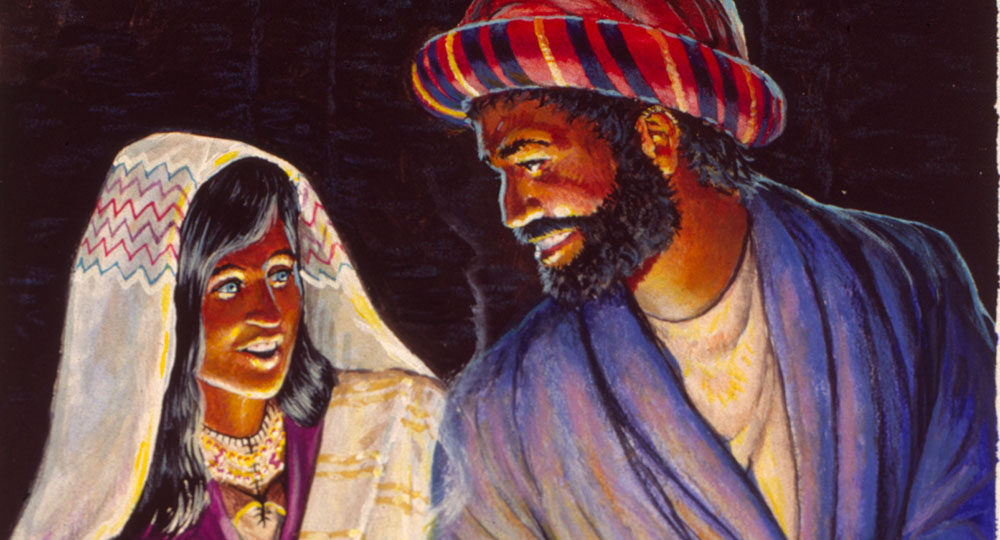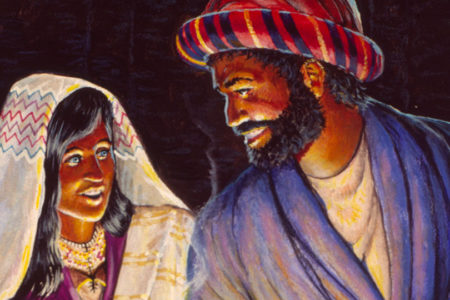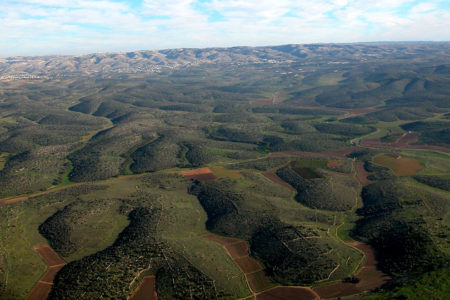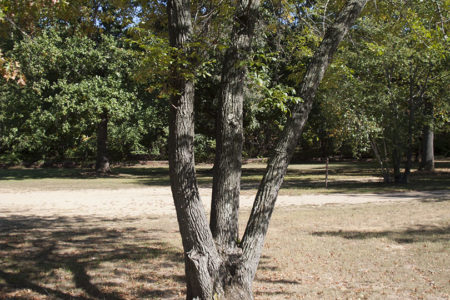Ruth and Boaz: The Story of the Kinsman-Redeemer
The Jewish community has always looked upon marriage as a sacred and divine institution. It is viewed as a holy covenant between a man and a woman, a necessity for the divine plan to propagate the human race (Gen. 1:28), and so important that even the study of the Torah could be put aside to celebrate with and bring joy to a newly married couple.
Statements from Jewish sources capture the importance of marriage in the Jewish community. The Talmud says, “One who does not have a wife lives without joy, without bliss, without happiness.” The sages said, “One who dwells without a wife is as one who dwells without blessing.” Rashi, the great 11th-century biblical and talmudic scholar and rabbi, said, “A woman has no security until she marries.” Marriage is seen as necessary to basic, healthy living (Gen. 2:18).
In the Bible God gave Israel a number of safeguards and requirements concerning marriage. Some of these can be seen in the relationship and marriage of Ruth and Boaz.
Ruth
Ruth was a Moabitess—a Gentile—who married into the family of Naomi when she wed Mahlon, the son of Naomi and her deceased husband Elimelech. Sometime after the marriage Mahlon died, and Ruth was left a widow with no children.
Ruth had obviously learned of the God of Israel from her new family, and her commitment to Him was genuine, as evidenced by her statement to Naomi, “thy people shall be my people, and thy God, my God” (1:16). This was in response to Naomi’s insistence that Ruth stay with her own people after the death of Mahlon, while Naomi returned to Israel and her people.
Jewish tradition tells us that Ruth was the daughter of Eglon, king of Moab. According to the Midrash, her beauty was outstanding “as that of a young girl,” even though she was about 40 years of age. Her character was impeccable, and humility and modesty were among her greatest virtues.
Unknown to Ruth, God had already provided for her welfare in the laws of marriage that were established in the Mosaic system. The unfolding of the story in the Book of Ruth shows us the matchless grace of our God.
Boaz
Boaz was a man of great wealth and influence in the community of Israel (2:1; 4:1–2). It is believed by the rabbis that he was a member of the Sanhedrin, the ruling body of Israel. Boaz was recognized as a very generous and gracious man, as illustrated by his concern and provision for Ruth.
Boaz was a kinsman of Naomi’s deceased husband Elimelech. Although the Bible does not tell us his specific relationship to Elimelech, Jewish tradition suggests that he was Elimelech’s nephew and therefore the cousin of Mahlon (Boaz’s father being the brother of Elimelech).
Boaz was from the city of Bethlehem in Judah and was believed to be much older than Ruth. According to the rabbis, Boaz was about 80 years of age when he married Ruth. He is believed to have been a widower with no children at the time of their marriage.
God provided for the childless widow in the Old Testament through what is referred to as Levirate marriage.
If brethren dwell together, and one of them die, and have no child, the wife of the dead shall not marry outside the family unto a stranger; her husband’s brother shall go in unto her, and take her to him as his wife, and perform the duty of an husband’s brother to her. And it shall be, that the first-born whom she beareth shall succeed in the name of his brother who is dead, that his name be not put out of Israel (Dt. 25:5–6).
A man was required to marry his deceased brother’s childless wife, raise up a child, and thereby perpetuate the name of the deceased in Israel.
When it was discovered that Boaz was a near relative of Mahlon, Naomi rejoiced that God had provided a potential husband for Ruth (2:20). She then put into motion a plan to get Boaz to fulfill his responsibility to Ruth.
It is likely that the marriage of Ruth and Boaz was not technically a Levirate marriage as outlined in Deuteronomy 25. In a Levirate marriage, a brother was commanded to marry the widow; Boaz was a cousin, not a brother. Yet it is probable that the custom of raising up an offspring by a near relative was present in Israel before this command was given in the Law of Moses (see the account of Judah and Tamar in Genesis 38).
Chalitzah
Deuteronomy 25:7–10 records a ceremony known as Chalitzah, which is performed for a man who refuses to fulfill his obligation of Levirate marriage.
And if the man desire not to take his brother’s wife, then let his brother’s wife go up to the gate unto the elders, and say, My husband’s brother refuseth to raise up unto his brother a name in Israel; he will not perform the duty of my husband’s brother. Then the elders of his city shall call him, and speak unto him; and if he stand to it, and say, I desire not to take her, Then shall his brother’s wife come unto him in the presence of the elders, and loose his shoe from off his foot, and spit in his face, and shall answer and say, So shall it be done unto that man who will not build up his brother’s house. And his name shall be called in Israel, The house of him who hath his shoe loosed.
When Ruth went to Boaz, lay at his feet during the night, and uncovered his feet (3:4, 7), it is believed that she was reminding him of his responsibility as a kinsman-redeemer to fulfill his obligation to marry her. The uncovering of his feet is believed to be an allusion to the Chalitzah ceremony.
Boaz recognized his responsibility; but he also knew that there was another man who was a closer kinsman than he (3:12–13). If the nearer kinsman wouldn’t fulfill his duty, Boaz was willing to marry Ruth and raise up seed.
The Nearer Kinsman
In chapter 4, verses 1 and 2, Boaz called the nearer kinsman to the gate of the city and asked for ten elders to join them to be public witnesses to the encounter. Boaz asked the nearer kinsman if he would be willing to redeem not only the land inheritance of Elimelech but also Ruth, the wife of Mahlon. That kinsman was willing to redeem the land inheritance but not the inheritance of Ruth by marrying her and raising up an offspring. The nearer kinsman believed that he would ruin his inheritance by marrying Ruth and thus declined to fulfill his responsibility. There are a number of possible reasons why he refused to fulfill the duty of a kinsman-redeemer.
First, if he were already married with children, his inheritance would have been ruined with another wife and children. Second, a Jewish person was not to marry a Gentile (Dt. 7:2–3). Perhaps the nearer kinsman felt that marriage to Ruth, a Gentile, would mar his inheritance. Third, being a Moabite, Ruth and her offspring were prohibited from entering the congregation of the Lord (Dt. 23:3–4). Whatever the reason, the nearer kinsman declined to fulfill his obligation as the kinsman-redeemer.
The ceremony that followed this decision (4:7–11) is often said to be the ceremony of Chalitzah; however, a number of factors indicate that it probably was not that ceremony. First, Ruth was not even present—only Boaz was there. Second, Boaz took off his shoe and gave it to the near kinsman, instead of Ruth removing the shoe of the near kinsman. Third, Ruth did not spit in the face of the near kinsman. Fourth, Boaz purchased the right of redemption. In the Chalitzah, that right was taken rather than purchased.
What probably took place was an ancient custom of releasing a man from his obligation. Speaking of this event, H. H. Rowley says, “The drawing off of the shoe here signified the abandonment of the obligation resting on the kinsman in respect of the property and in respect of Ruth, and it clearly opened the way for Boaz to do what he could not else have done.”
Boaz then fulfilled the obligation of kinsman-redeemer by marrying Ruth and raising up seed with her to perpetuate the name of Mahlon, as required by the Law (4:10). Out of this union came the Messianic line, and, thereby, Ruth had the blessing of being a Gentile woman in the lineage of Jesus the Messiah.
Portrait of the Messiah
In the Jewish Scriptures, events are recorded that are shadows or pictures of truths or events presented in the New Testament. Many of these prophetic events were fulfilled in the person of the Messiah (Col. 2:15–17). Such an event in the Jewish Scriptures is referred to as a “type.” The fulfillment in the New Testament is the “anti-type.”
The Bible records numerous types: The Passover in the Jewish Scriptures (type, Ex. 12) is fulfilled in the New Testament in Jesus, the Passover Lamb (anti-type, 1 Cor. 5:6–8). Melchizedek (type, Gen. 14) relates to Jesus in the priesthood according to the order of Melchizedek (anti-type, Heb. 7). Jonah and the fish (type, Jon. 2) are related to Jesus’ resurrection (anti-type, Mt. 12:40). The Day of Atonement (type, Lev. 16) is fulfilled in Jesus, our High Priest (anti-type, Heb. 9). Many other clear examples of typology could be shown. Also, some events in the Old Testament not specifically recognized as types are nonetheless clear types of New Testament events. Although we must exercise care in this area in order not to develop fanciful pictures, we are fully justified in labeling an event in the Old Testament a type if there is a clear parallel in a New Testament event. The story of Ruth and Boaz fits this criterion.
Explanations are given of how Boaz could marry a Gentile woman—a Moabitess—without breaking the commands of the Law. Without detailing these explanations or their possible accuracy, let me suggest a reason for the series of events that led to the marriage of Ruth and Boaz.
Boaz was a Jewish man who undoubtedly possessed and exhibited grace and compassion. His concern and care for Ruth exemplified this fact. Ruth mentioned the grace or favor she found in Boaz’s eyes: “Then she fell on her face, and bowed herself to the ground, and said unto him, Why have I found grace in thine eyes, that thou shouldest take knowledge [notice] of me, seeing I am a foreigner?” (2:10). There was no reason for Boaz to have responded so favorably to this Gentile woman. It went against all that he believed, as revealed in the Law. Yet he had compassion and mercy on her to the extent that he did everything he could to redeem her and provide for her through marriage.
This is quite possibly the clearest picture in the Old Testament of the Messiah’s love for the Gentiles and His church. Gentiles were “without Christ, being aliens from the commonwealth of Israel, and strangers from the covenants of promise, having no hope, and without God in the world” (Eph. 2:12).
Ruth is a picture of the Gentiles (and, in a greater sense, both Jews and Gentiles) who have lost their inheritance. Sin has ruined our right of inheritance and separated us from God (Rom. 7:9–14). We have no right or ability to redeem what we have lost. Ruth was in exactly this condition.
Boaz is a picture of Jesus the Messiah. Boaz alone met all the requirements of the kinsman-redeemer. Jesus alone meets all of the requirements of our Kinsman Redeemer. Boaz showed favor toward Ruth, redeemed her, and restored her inheritance. Jesus showed favor toward us, redeemed us, and restored our lost inheritance (Eph. 2:13–22). A Jewish Messiah took to Himself a predominantly Gentile bride. All—Jew or Gentile—who are redeemed in this age are the bride of the Messiah (Eph. 5:22–33).
A portrait of the Messiah and His gracious love is clearly seen in the lives of Ruth and Boaz. It is truly a picture of His love for you and me. Just as Boaz willingly redeemed and restored Ruth to her full inheritance, so Jesus the Messiah wants to do the same for you. Will you enter into marriage with Him? To do so, you must be willing to say, “I do.”









Ruth was not a gentile. Ruth was an Israelite of the Tribe of Reuben. Israel conquered the Amorites. The Amorites had conquered the northern half of Moab some 400 years before the Israelites arrived. This northern half, that the Amorites conquered, contained The Plains of Moab. The Plains of Moab (in Reubenite territory) was where Naomi went to sojourn. Ruth was born in The Plains of Moab in Reubenite territory. ALL THE AMORITES (AND ALL OF THE MOABITES THAT THE AMORITES ENSLAVED)…MEN, WOMEN, AND CHILDREN…that were living in the Amorite territory were killed by the Israelites.
Ruth could not have been allowed to marry Boaz if she was a DAUGHTER of Moab (which she was NOT). A Moabite had to wait 10 generations.
Here’s the breakdown:
Ruth was already a Reubenite who worshipped YAHAWA. Ruth left the judges and the people of Reuben to sojourn with the judges and people of Judah.
Ruth did not convert to Judaism. Judaism had not yet been invented. Ruth worshipped the God of Israel, YAHAWA. All 12 tribes still formed the United Tribes of Israel (U. T. A.)…this was the time when the judges (allehayim) ruled (the time of the Book of Judges).
Your explanation is well understood. it makes me understand God’s plan of our redemption especially as a gentile. God through Ruth’s involvement in the genealogy lineage of Jesus reaches unto the gentile world.
Your thoughts on the love between Boaz and Ruth are beautiful. They touch my heart. I’ve read & studied their story many times but felt God’s Love in your description more than many other times. I believe it is because God put His Blessing on your words. God bless you.
I really enjoyed reading about Ruth and how she became in the lineage of Jesus. This is a marvelous story of love between two people. I feel all that happened for Ruth was in God’s hands. Thank you for this article to read and learn from it.
Thank you. I have always been curious about Ruth and I did not know that she became in the lineage of Jesus!! Interesting since she was a gentile.
Not only Ruth, but Tamar, the Jericho city prostitute, Bathsheba!
The Bible does not mention Bathsheba’s lineage. She was probably an Israelite,… because she was allowed to do the mikva ritual cleansing after her period. She married a Hittite warrior who would have had to have been a converted worshipper of Yahawa, and likely circumcised.
Rahab The Harlot’s name in Greek is ‘RaaB’.
The Israelite woman who married Salmon, her name in the Greek is ‘RaXaB’.
Note that Rahab The Harlot and her family had to reside outside of the camp of Israel.
It was highly inappropriate for the chief elder of the Tribe of Judah to marry a non-Israelite woman.
Yes, but Rahab was Boaz’s mother. This raises several questions for me: Did Boaz grow up outside the camp of Israel? It is likely, with Rahab’s actions to save the spies, her subsequent salvation from destruction, and her marriage, that she was grateful and lived a changed life. Is it possible Boaz had greater compassion for Ruth because he had grown up seeing his mother outcast–yet knowing her heart–and he could see something similar in Ruth? There are no accidents with God. Could it be…that Rahab was Boaz’s mother…in order to prepare his heart to willingly serve as kinsman redeemer for Ruth…in order that we might have a beautiful picture and greater understanding of Christ’s compassion for us as He willingly serves as our Kinsman Redeemer in spite of our unworthiness? What an incredible master planner is our God!
This really ministered to me today. Thank you for this article. God Bless!!
I really appreciate this article. I’m trying to do a study on the book of Ruth. I think there are so many things about ancient Israel that I don’t understand. I wish I knew more. The meeting between Ruth and Boaz can seem very clandestine. I wish I knew more about what was going on there. Was Boaz drunk the night after winnowing? Was Naomi trying to run God’s will for herself like Sarah and Abraham when they had Ishmael? It would be nice to have an intelligent discussion with someone who knew more about the history of this time.
When a kinsman redeemer would not perform his obligation to a widow, she would remove his shoe and spit in his face. When Ruth uncovered Boaz’ feet, it was a subtile reminder to him that she might have to remove his shoe and spit in his face if he didn’t perform his obligation. Laying at his feet was also, likely, a demonstration to Boaz that his age was not a problem for her.
Your explanation about marriage is impressed me a lot so I will teach it to the other.